Types of Shock
There are four basic types of shock: hypovolemic shock cardiogenic shock distributive shock and obstructive shock
Related Video – Types of Shock
Hypovolemic Shock
Hypovolemic shock is caused by a significant decrease in intravascular volume. It is the most common cause of shock in infants and children since they are prone to diarrhea and dehydration that cause extravascular fluid loss. Hemorrhage from trauma and other medical conditions causes intravascular fluid loss. Hypovolemic shock may also be caused by osmotic diuresis in patients with diabetic ketoacidosis or extensive burns.
The loss of intravascular volume decreases preload. A decrease in preload depresses cardiac output, leading to shock. The body compensates by increasing heart rate, myocardial contractility, and SVR.
Primary Assessment Findings in Hypovolemic Shock
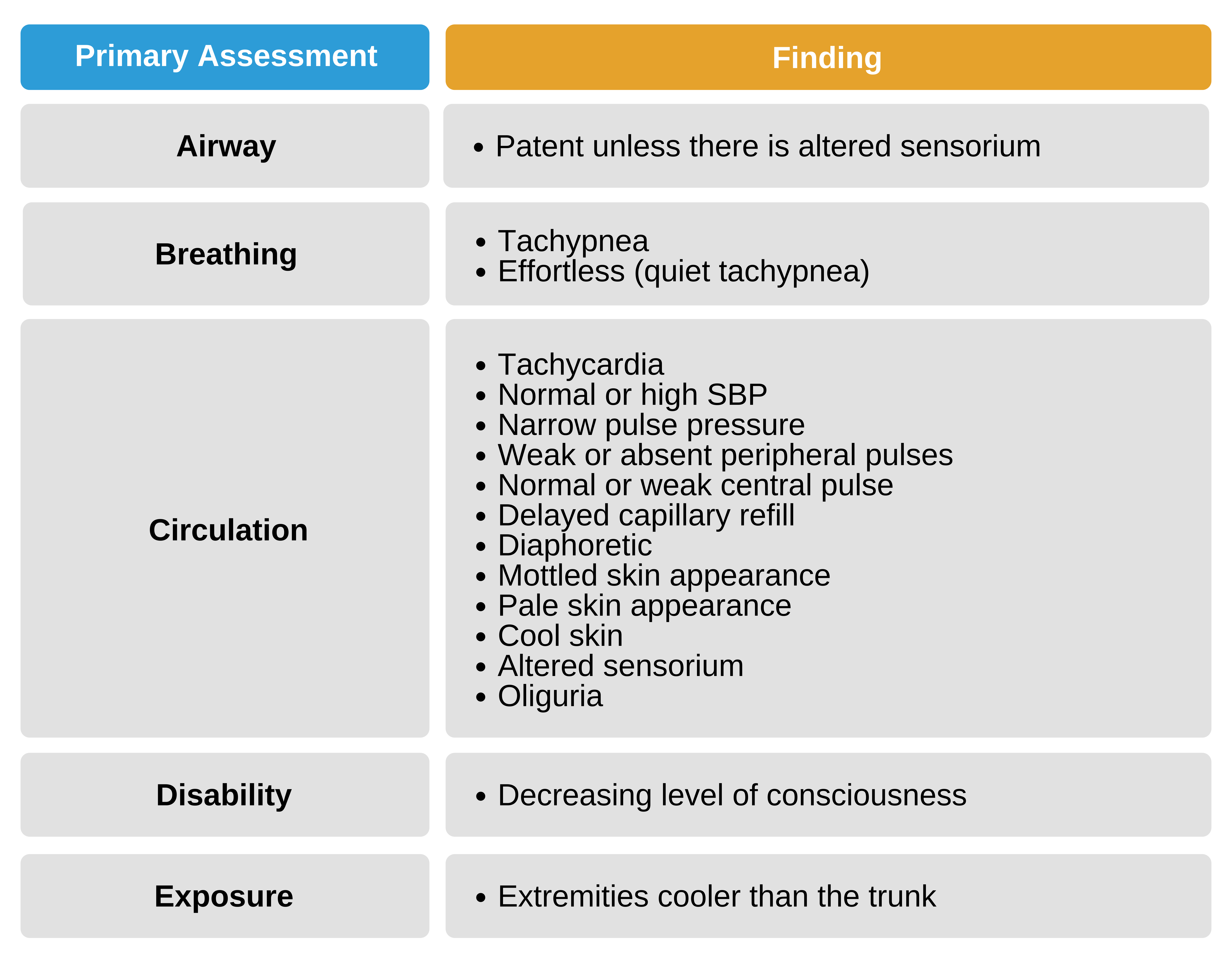
Primary Assessment Findings in Hypovolemic Shock
Distributive Shock
The leading cause of distributive shock is reduced SVR, which causes a maldistribution of blood volume and flow. Categories of distributive shock include septic shock, anaphylactic shock, and neurogenic shock (seen in spinal injury).
The main problem in distributive shock is the maldistribution of blood flow. Some tissues may be poorly perfused, while others may have excessive perfusion that exceeds metabolic needs. As the disease progresses, so does cardiac output, and the signs and symptoms of these patients may follow that of the other types of shock.
Central venous oxygen concentration may be normal or increased in distributive shock, particularly in septic shock. Due to the maldistribution of blood flow, tissues that have more blood flow will not utilize more oxygen, while tissues with reduced blood flow cannot extract enough oxygen. The net oxygen extraction of blood is decreased, causing a normal or increased ScvO2.
Primary Assessment Findings in Distributive Shock
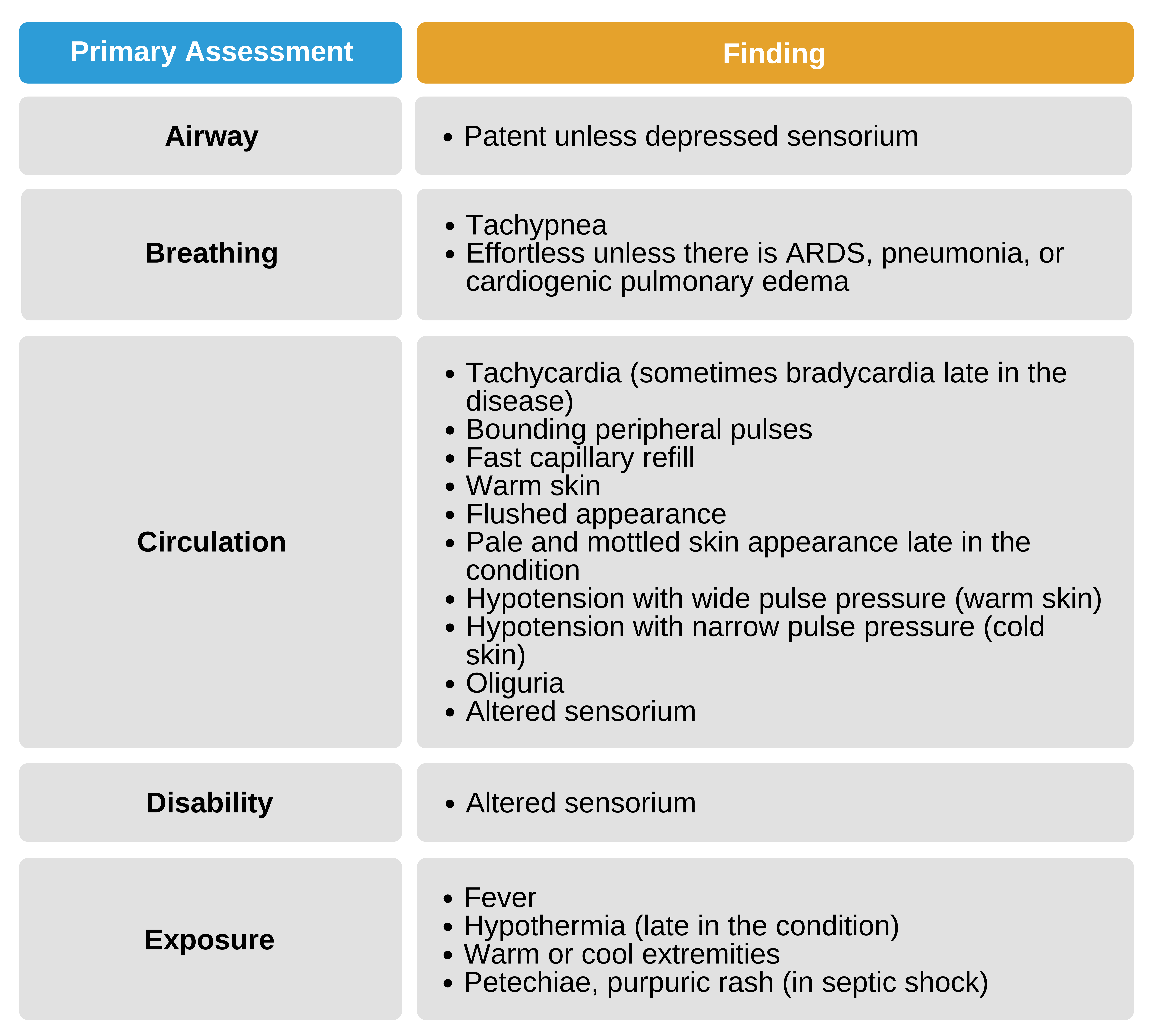
Primary Assessment Findings in Distributive Shock
Septic Shock
Septic shock is caused by an infectious agent or an inflammatory stimulus and is a common cause of shock in pediatric patients. Sepsis causes the blood vessels to dilate and increases capillary permeability. Septic shock is confirmed with ancillary tests that prove the presence of pathogens.
These pathogens produce endotoxins that elicit an immune and inflammatory response in the form of cytokines. Cytokines induce vasodilation and activate the coagulation cascade, causing disseminated intravascular coagulation (DIC). The toxins and inflammatory mediators in this disease process prevent aerobic metabolism, and shock leads to lactic acidosis and end-organ dysfunction.
Clinical signs of septic shock include fever, metabolic acidosis, respiratory alkalosis, the presence of a petechial or purpuric rash, and either an increased or decreased white blood cell count. The white blood cell count may show a left shift with an increase in the bands and immature WBCs.
Anaphylactic Shock
Anaphylactic shock is an acute and severe reaction to allergens, causing a multisystem response that results in venous or arterial vasodilation, increased capillary permeability, and pulmonary vasoconstriction.
Pulmonary vasoconstriction in anaphylactic shock causes increased right heart afterload and reductions in pulmonary blood flow, pulmonary venous return, and preload in the left ventricle, leading to decreased cardiac output. The patient can deteriorate immediately and succumb to cardiac arrest within 10 minutes after exposure.
Primary Assessment Findings in Anaphylactic Shock

Primary Assessment Findings in Anaphylactic Shock
Neurogenic Shock
A traumatic injury to the spinal cord above the level of the T6 vertebra can affect sympathetic nervous system innervation to the blood vessels and the heart. A disruption in these sympathetic nerve innervations can cause uncontrolled vasodilation and prevent the heart from increasing its rate to compensate for sudden hypotension.
The loss of these compensatory mechanisms differentiates neurogenic shock from hypovolemic shock. Hypovolemic shock is associated with hypotension, narrow pulse pressure, and tachycardia. In contrast, patients with neurogenic shock present with hypotension, a wide pulse pressure, bradycardia, and hypothermia. The child in neurogenic shock can also have respiratory problems because innervation of the muscles for breathing may also be compromised following the spinal cord injury.
Related Video – Neurogenic Shock Versus Spinal Shock
Cardiogenic Shock
Cardiac malfunction is a leading cause of cardiogenic shock, which results in decreased systolic function and decreased cardiac output. In pediatric patients, congenital heart disease, myocarditis, cardiomyopathy, arrhythmias, sepsis, drug toxicity, and trauma can be causes of cardiogenic shock.
Cardiogenic shock prompts tachycardia, which demands even more work from the heart muscles and prompts further myocardial oxygen consumption. Additionally, the body compensates for cardiogenic shock by increasing SVR in order to maintain perfusion to the brain and heart. This compensatory increase in SVR often worsens the condition because it can further increase left ventricular afterload, stressing the left ventricle even more, and this increases myocardial oxygen demand. Since oxygen is scarce in shock, myocardial function declines further, and the pediatric patient may deteriorate rapidly.
Pulmonary edema is a common finding in cardiogenic shock. An increase in respiratory effort due to pulmonary edema can help the clinician differentiate cardiogenic shock from hypovolemic shock. Pulmonary edema occurs when venous tone increases due to a backup of blood flow to the venous circulation. This causes an increase in central venous and pulmonary capillary pressures. Poor cardiac output also reduces renal perfusion, resulting in fluid retention and edema. Finally, significant left ventricular dysfunction produces elevated left ventricular end-diastolic and atrial pressures, and a high pulmonary venous pressure causes pulmonary edema.
Primary Assessment Findings in Cardiogenic Shock

Primary Assessment Findings in Cardiogenic Shock
Obstructive Shock
Medical conditions that mechanically obstruct blood flow and limit venous return to the heart or limit the heart’s pumping action cause obstructive shock and decrease cardiac output. Common causes of obstructive shock include pericardial tamponade, tension pneumothorax, ductal-dependent congenital heart defects, and massive pulmonary embolism.
Obstructive shock and hypovolemic shock can present with the same clinical findings early in the disease. The clinician should look for signs of systemic or pulmonary venous congestion when differentiating obstructive shock from hypovolemic shock. As obstructive shock progresses, the patient will begin to experience increased respiratory effort, cyanosis, and signs of vascular congestion.
Cardiac Tamponade
Protecting the heart is a thin sheath known as the pericardium. There is a space between the myocardium and pericardium where fluid, blood, or air can accumulate in certain medical conditions and can be significant enough to restrict heart wall motion, reduce ventricular filling, and decrease cardiac output.
Cardiac tamponade in children can be iatrogenic secondary to cardiac surgery or trauma. Inflammation or infection of the heart or pericardium or the presence of a tumor are other causes of cardiac tamponade.
Pulsus paradoxus is a reliable finding in patients with cardiac tamponade. It is present when there is more than a 10 mm Hg decline in systolic blood pressure during inspiration.
Cardiac tamponade can eventually result in cardiac arrest. Pulseless electrical activity is a common lethal arrhythmia in the presence of cardiac tamponade.
Related Video – Cardiac Tamponade
Primary Assessment Findings in Obstructive Shock Secondary to Cardiac Tamponade
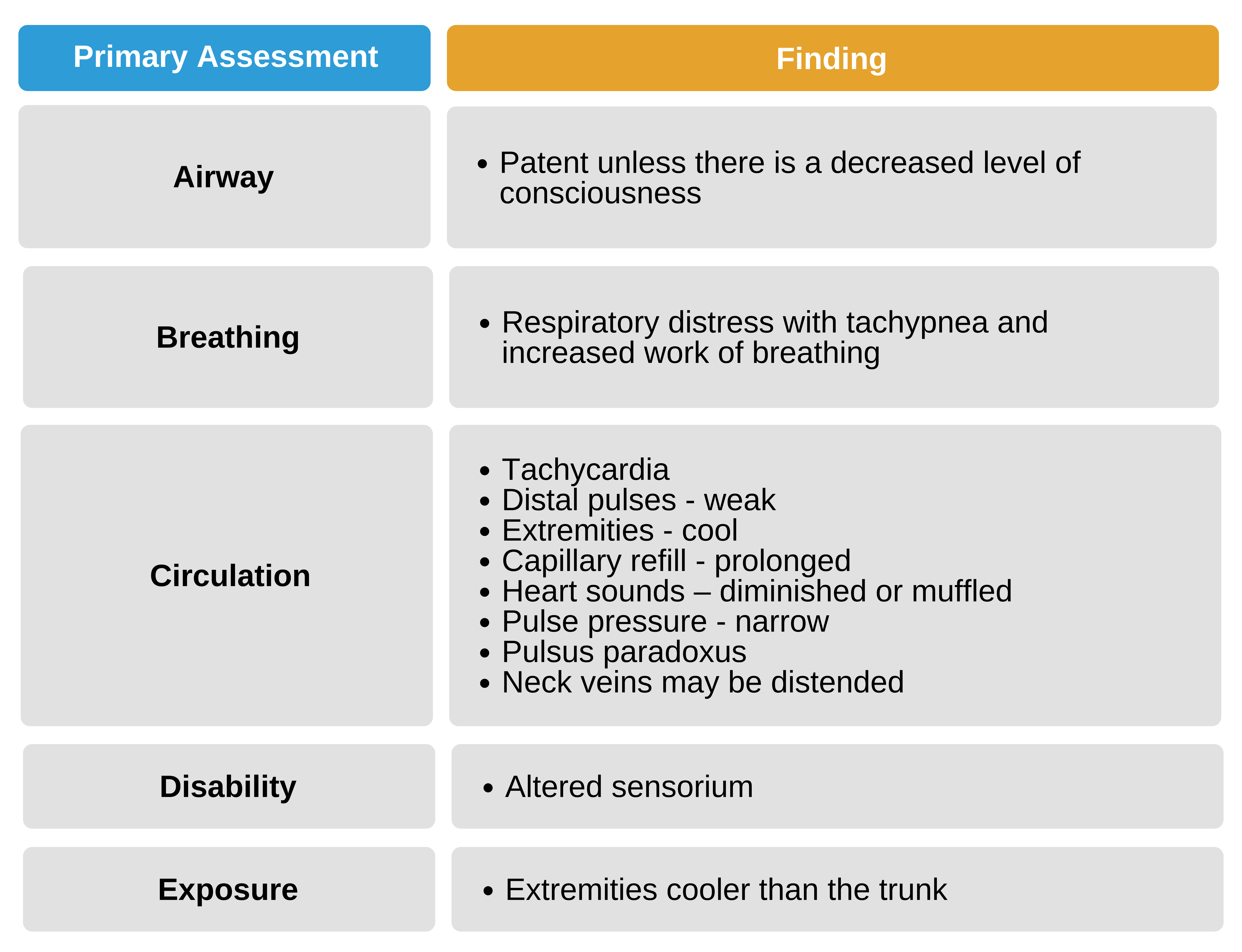
Primary Assessment Findings in Obstructive Shock Secondary to Cardiac Tamponade
Tension Pneumothorax
Increased intrapleural pressure due to air leakage from the lungs can lead to a tension pneumothorax. A tension pneumothorax is usually caused by a tear in the pulmonary parenchyma, either iatrogenic or traumatic. When left untreated, the pressure increases to the point that there is constriction of the mediastinal structures and the contralateral lung.
Related Video – What is Pneumothorax?
Compression of the lungs can lead to respiratory failure. Constriction of the mediastinal vessels can lead to decreased venous return, which in turn reduces cardiac output and causes hypotension. A tension pneumothorax can cause cardiac arrest with pulseless electrical activity.
Trauma patients should be assessed for a possible tension pneumothorax during the primary assessment. Sometimes a tension pneumothorax can spontaneously heal itself, and this is known as a simple pneumothorax.
Primary Assessment Findings in Obstructive Shock Secondary to Tension Pneumothorax
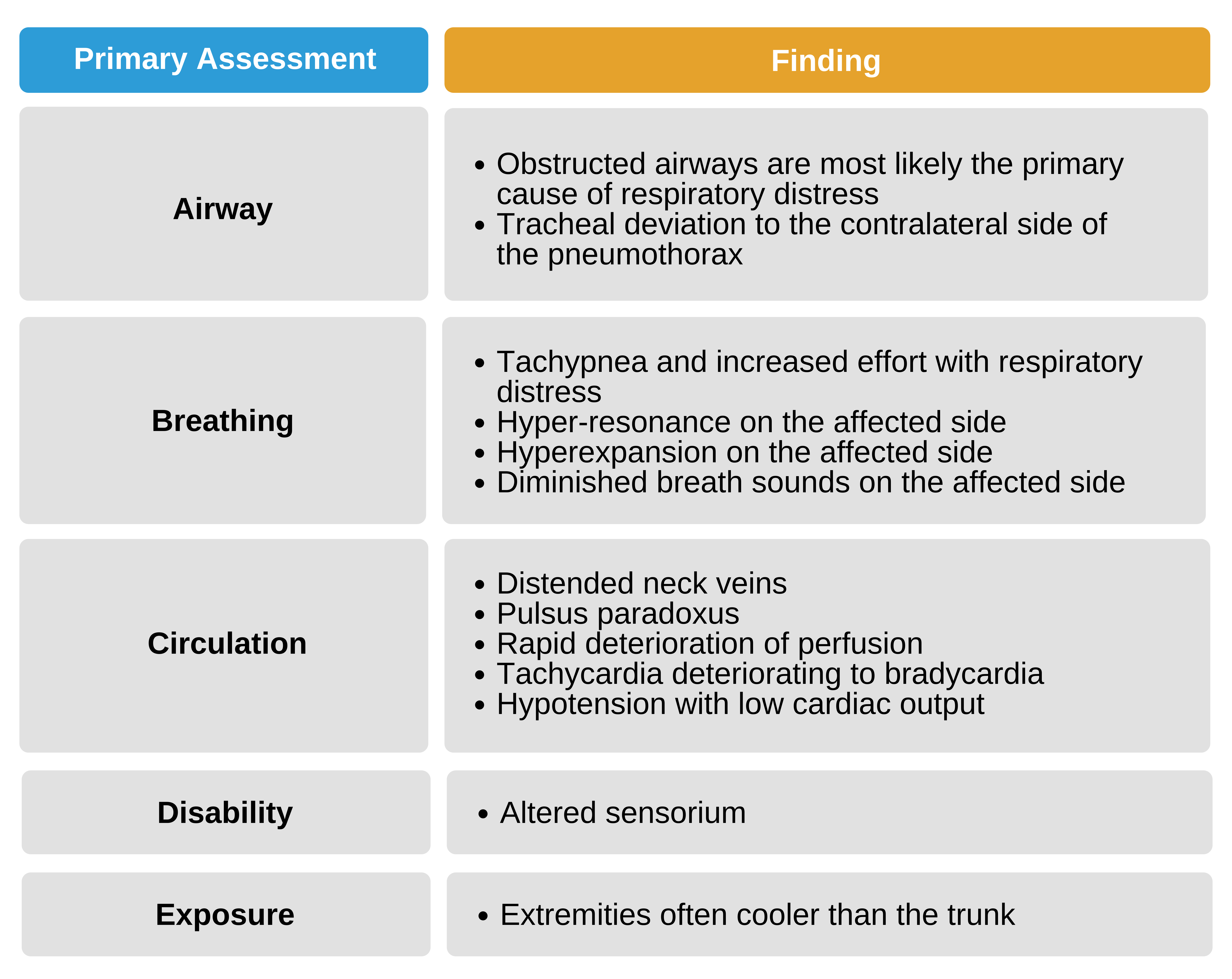
Primary Assessment Findings in Obstructive Shock Secondary to Tension Pneumothorax
Ductal-Dependent Congenital Cardiac Abnormalities
Ductal-dependent congenital cardiac abnormalities can cause cyanotic congenital heart lesions and left ventricular outflow obstructions. Cyanotic congenital heart disease is present if the ductal malformation is dependent on pulmonary blood flow. An obstructive lesion is present if the ductal malformation is dependent on the systemic blood flow.
Coarctation of the aorta, interrupted aortic arch, critical aortic valve stenosis, and hypoplastic left heart syndrome are congenital cardiac lesions that may cause obstructive shock, especially in the first few days of life when the ductus arteriosus closes. Prior to corrective surgery, keeping the ductus arteriosus patent is a crucial component of survival for these patients.
The ductus arteriosus provides the only pathway for blood flow to enter the systemic circulation. The provider must be able to diagnose a ductal-dependent lesion so that rapid interventions to keep the ductus arteriosus patent can improve the outcome and survivability of the patient.
Primary Assessment Findings in Obstructive Shock Secondary to Ductal Lesions from Congenital Heart Disease
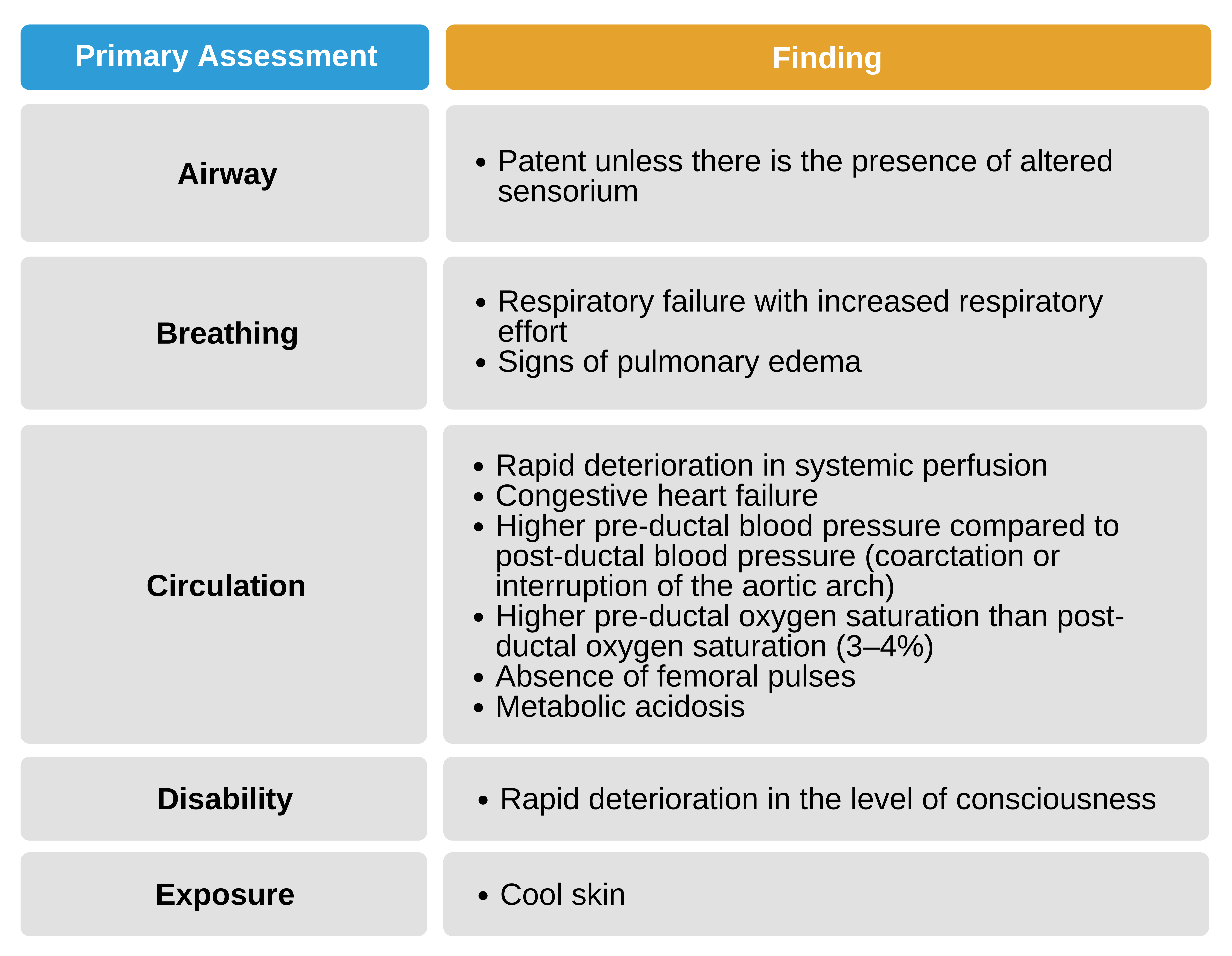
Primary Assessment Findings in Obstructive Shock Secondary to Ductal Lesions from Congenital Heart Disease
Pulmonary Embolism
Obstruction due to a thrombus, fat, amniotic fluid, air, or any injected matter in the pulmonary artery or its branches is known as a pulmonary embolism (PE) This condition is not common in children. Susceptible pediatric patients have sickle cell disease, malignancies, connective tissue disorders, and coagulation disorders. Also, the placement of intravenous catheters is a risk factor for PE.
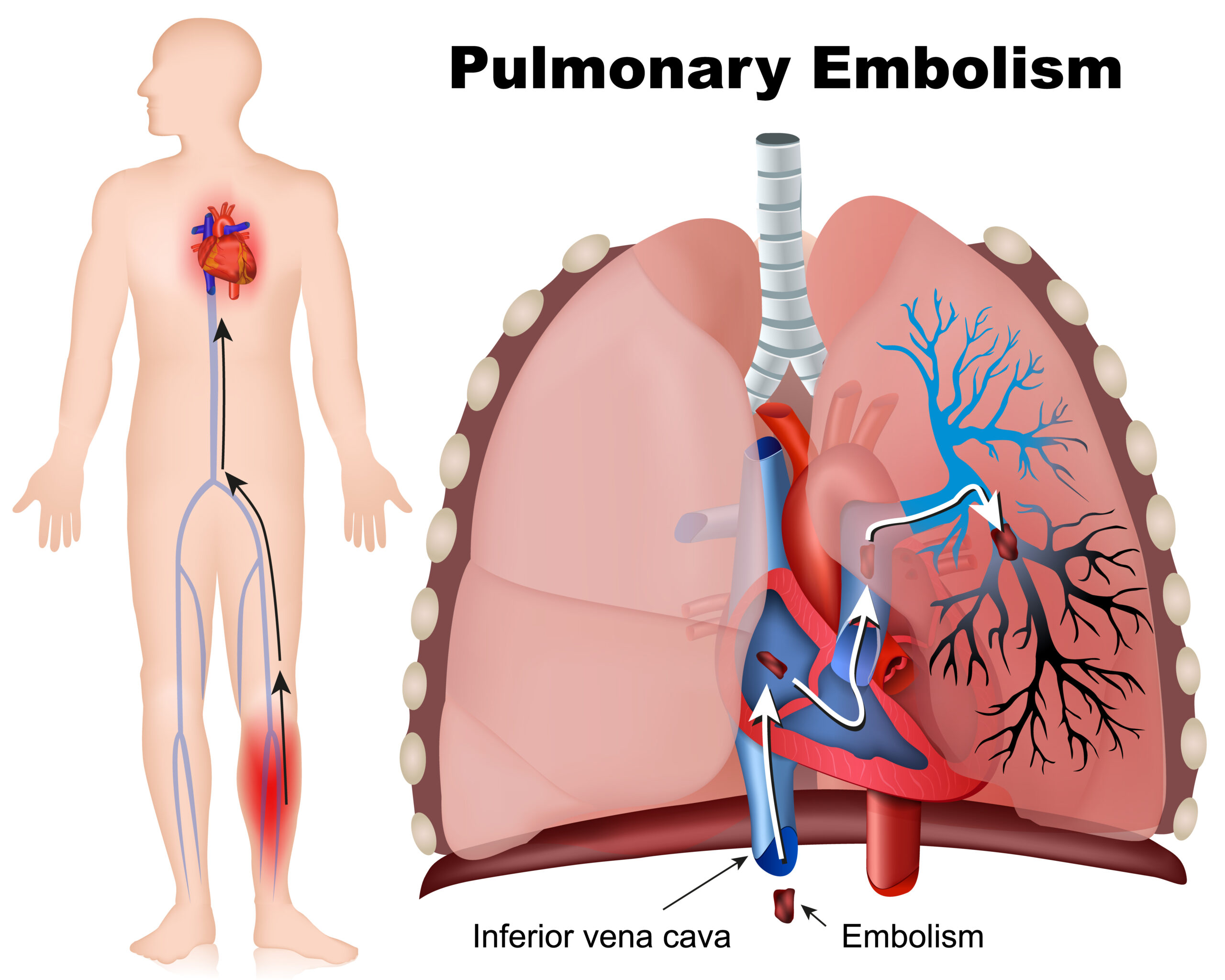
Pulmonary Embolism
There is a ventilation-perfusion (V/Q) mismatch in a pulmonary embolism due to obstruction of the pulmonary vasculature. It is difficult to diagnose without the help of ancillary procedures such as a V/Q scan, a nuclear medicine procedure.
Clinical symptoms are nonspecific and may include cyanosis, tachycardia, and hypotension. PE can be differentiated from hypovolemic shock if there are signs of systemic venous congestion and right-sided heart failure. Pediatric patients may also report chest pain, which is indicative of ischemia in the pulmonary vessels.
Primary Assessment Findings in Obstructive Shock Secondary to Pulmonary Embolism
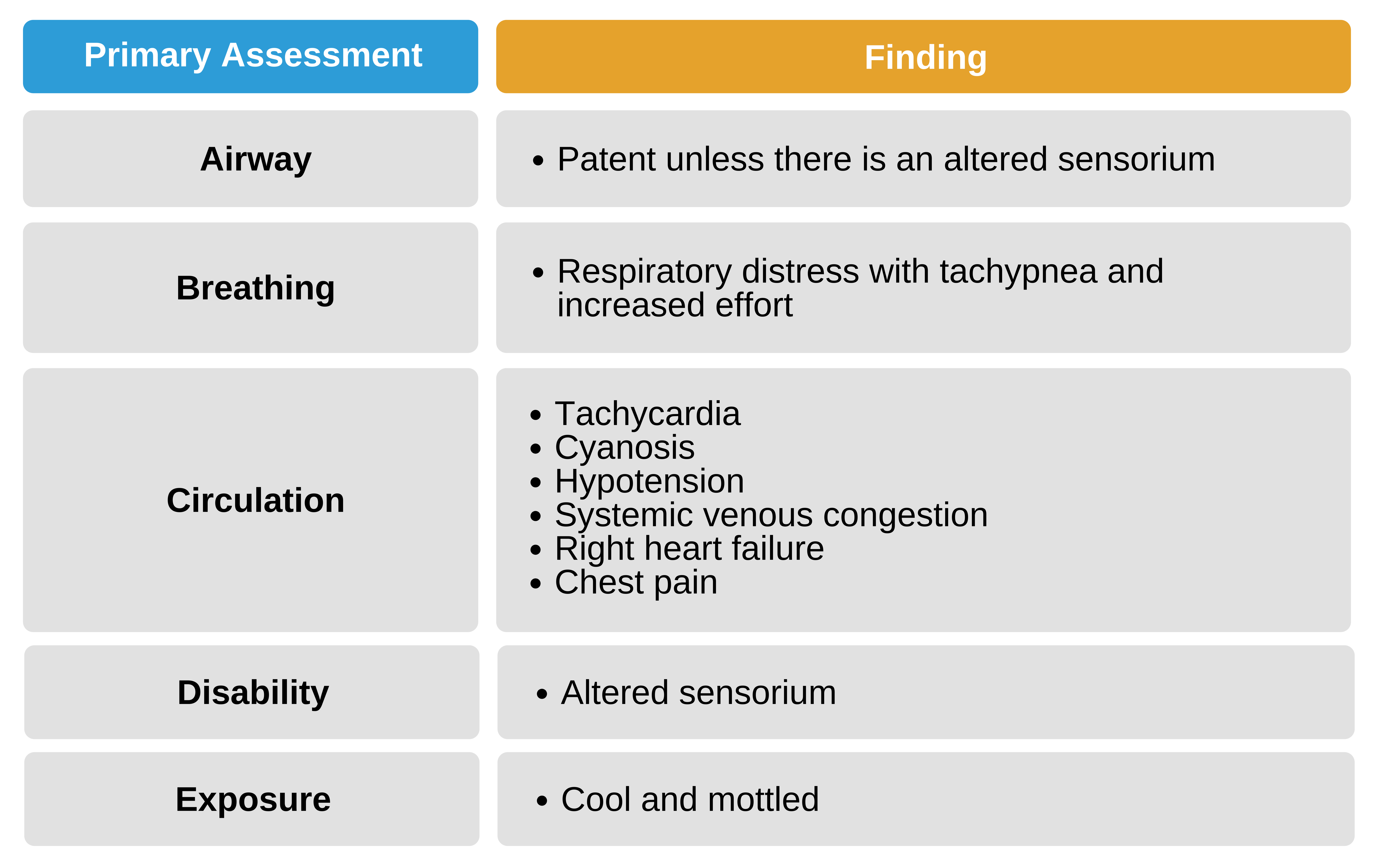
Primary Assessment Findings in Obstructive Shock Secondary to Pulmonary Embolism